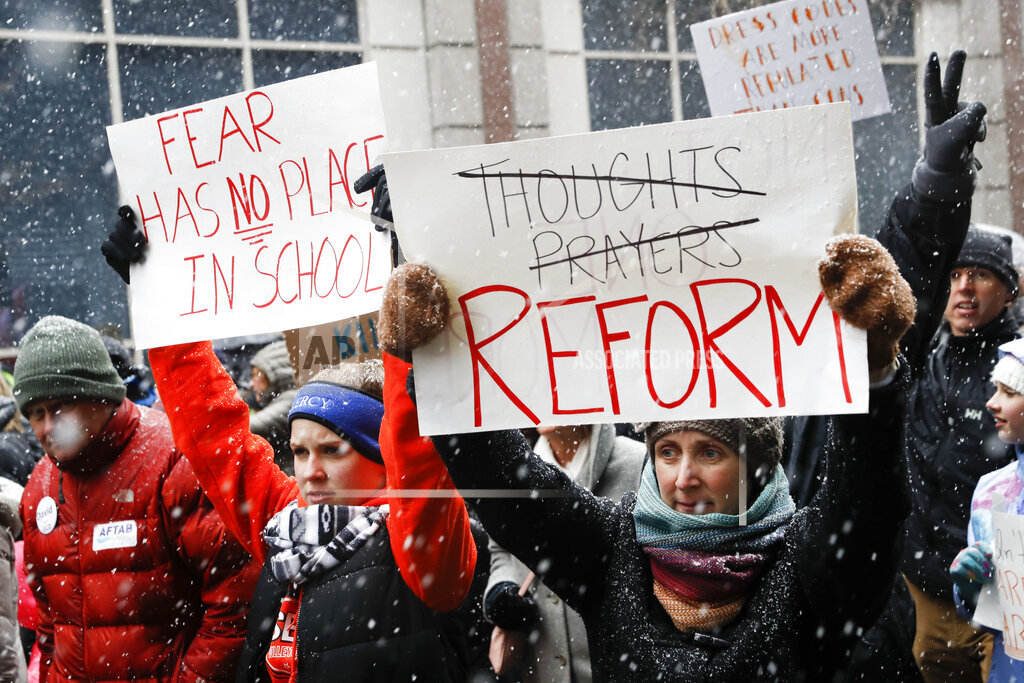
President Joe Biden faces an uphill battle as he tries to revive a push for more state laws that would allow authorities to temporarily disarm people who are considered a danger to themselves or others.
The political circumstances surrounding this year’s effort are drastically different than they were three years ago, when state lawmakers, governors of both parties and former President Donald Trump embraced the extreme-risk protection orders after the 2018 mass shooting that killed 17 people at a high school in Parkland, Florida.
Officials in Florida and several other states quickly adopted so-called red flag laws, hailing the court-ordered removal of guns from people judged to be dangerous as a way to prevent suicides, domestic violence and mass shootings. Trump’s commission on school shootings in December 2018 recommended that other states follow suit.
But momentum for the legislation has stalled after intense pushback from gun rights activists, increasing opposition from rank-and-file Republicans and key defeats for Democratic supporters of gun control in the November elections. Critics argue the laws can strip people of their right to bear arms based on unproven accusations, even as evidence mounts that they save lives.
Biden announced last week that his administration would publish model legislation in the next 60 days to encourage more states to pass red flag laws. His administration also is urging Congress to approve legislation giving states incentives to pass them, which could include millions of dollars in grant funding for implementation.
Still, advocates say they do not expect many, if any, of the 31 states without those laws to adopt them this year.
“We are now pushing against somewhat of a wall. The easier targets have been done,” said Josh Horwitz, executive director of the Educational Fund to Stop Gun Violence, which has played a key role in modeling the laws after domestic violence restraining orders. “But we’re in it for the long haul. I’m confident that in 20 years, this will be almost everywhere.”
Horwitz said the laws in many states are still new, and he is working to educate local officials on how to use them. He said a federal grant program to incentivize implementation would be a great step, and he is urging lawmakers not to wait for tragedies to act.
The measures typically allow police and family members to petition courts for civil orders to temporarily strip the gun rights of those who are exhibiting warning signs of violence. Emergency orders that last days can be issued immediately. Judges later determine whether to extend them up to a year, based on evidence presented at a hearing. Respondents can surrender their firearms or have them removed by police, and are barred from purchasing weapons as long as the order remains in effect.
Nineteen states have versions of the laws in place, and research suggests they can reduce suicides and prevent other forms of gun violence. Supporters say they allow people to work through mental health, substance abuse or other crises while unarmed. Thousands of orders have been granted to disarm suicidal, threatening or other unstable people, from California to Connecticut to Florida, although their use has been uneven based on the discretion of local officials.
Bills have been introduced in at least 14 states this year to adopt red flag laws, but have had no success advancing.
“It’s going to be a tougher fight in a lot of the remaining states,” said Allison Anderman, senior counsel with the Giffords Law Center to Prevent Gun Violence.
On March 31, a Tennessee House subcommittee voted down a bill sponsored by Democratic Rep. Gloria Johnson, who said the orders were “all about keeping people safe.” Republican Rep. John Gillespie said he worried the law “could be abused very, very quickly” because it would allow ex-spouses to file petitions. Another Republican said it would be worse than doing nothing because police could be put in harm’s way if forced to seize weapons.
Virginia was the last state to adopt the orders a year ago, after Democrats took over the General Assembly.
Biden said states with them have seen drops in suicides and that they can have a “significant effect in protecting women” from violence and disarming would-be mass shooters: “It’s time to put these laws on the books and protect even more people,” Biden said.
Horwitz said states do not need model legislation because that already exists. A research consortium in October published detailed recommendations for adopting the laws, including key provisions such as who can petition for the orders and how long they should last.
He said he was hopeful that more federal money might win over some state lawmakers. Congress is expected to consider creating a grant program that would help states pay for training court officials and police, collecting data, developing procedures and forms, and raising public awareness about the orders.
In Minnesota, the Republican-controlled Senate narrowly retained its majority in the November election after blocking a red flag proposal approved by the Democratic-controlled House and supported by Gov. Tim Walz, a Democrat. So far, the Senate hasn’t held a committee hearing on a new bill introduced by Democrats in February.
In New Hampshire, Republican Gov. Chris Sununu vetoed a red flag bill last August, saying it would “weaken the constitutional rights of law-abiding New Hampshire citizens.” With Sununu easily winning reelection and Republicans flipping both houses of the Legislature in the 2020 election, the momentum for the policy is dead.
National Rifle Association spokeswoman Amy Hunter said the state-by-state push has stalled due to “significant public opposition.” She said the laws can deny due process, allow false and malicious claims and do not provide mental health services for those who need them.
By RYAN J. FOLEY AP Writer